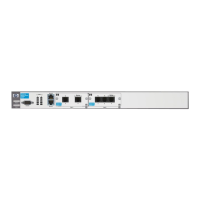2-60
Controlling Management Access to the ProCurve Secure Router
Using SNMP to Manage the ProCurve Secure Router
Use the no form of the command to remove a user from a specified group.
Syntax: no snmp-server user <username> <groupname> [v1 | v2c | v3 {auth [md5 |
sha] <password>} | {priv des <password>}]
Syntax: no snmp-server user <username> <groupname> [remote <SNMP server
address>] [v3 {auth [md5 | sha] <password>} | {priv des <password>}] [access
<listname>]
Configuring SNMP Traps and Informs
SNMP traps are used to report an alert or other event about a managed
device—for example, a WAN interface goes down, or the device reboots
unexpectedly. Traps are one-way notification messages; they are not acknowl-
edged by the receiving SNMP server (which may also be called the trap
receiver).
Traps can be configured and enabled by the following router commands:
■ snmp-server enable traps commands are used to enable and configure
SNMP trap generation on a global basis. All users in all groups with a view
of the router will receive trap notifications from it.
■ snmp-server host commands are used to configure SNMP notifications
to be received by a specific SNMP host, or server, which is identified by
its IP address.
For the snmp-server host command, you can configure a second type of
message, the inform notification. Inform notifications are similar to trap
messages, except that the managed device expects a response from the SNMP
server. Because inform notifications require two-way communication, the
ProCurve Secure Router will repeat the inform message periodically until the
SNMP server acknowledges the notification.
Enabling SNMP Traps
To enable the ProCurve Secure Router to send SNMP traps, enter the following
command from the global configuration mode context:
Syntax: snmp-server enable traps [snmp]
If you do not include the snmp option, only the system traps are enabled. If
you include the snmp option, you enable the SNMP traps listed in Table 2-13.
(These traps are outlined in Request for Comments [RFC] 1157.)

